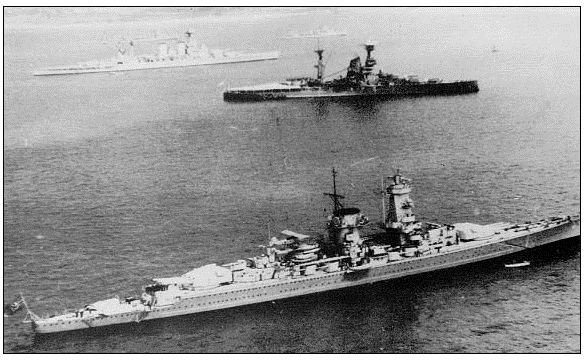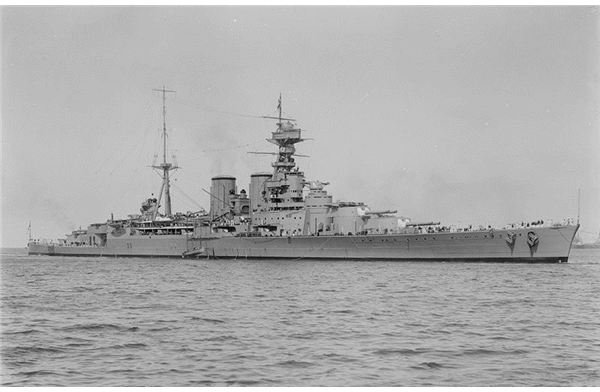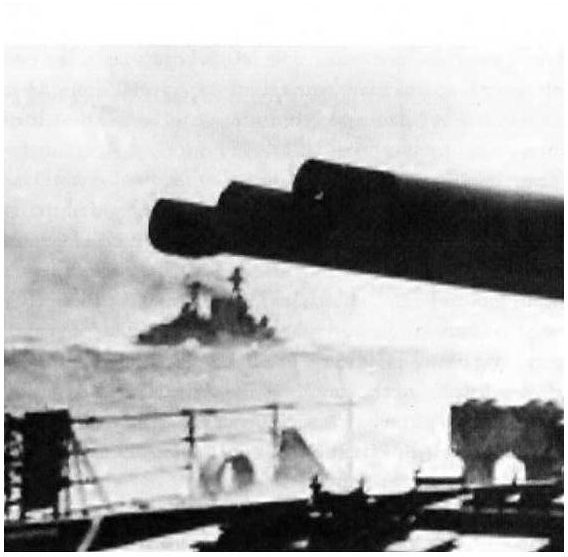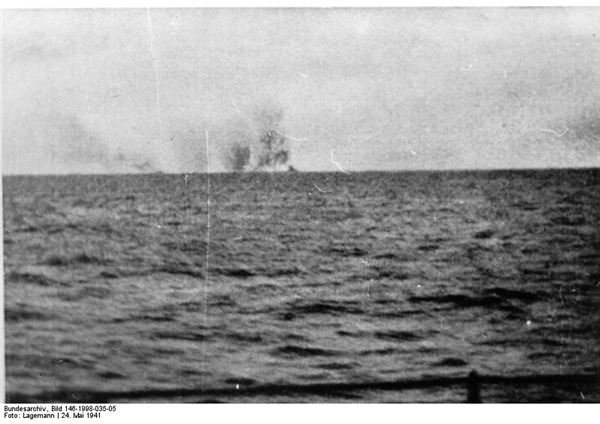Design and History of the HMS Hood: The Battle of the Denmark Strait
The Denmark Strait
Few naval bodies have played as significant a role in major military conflicts as the Denmark Strait. It functions as a naval chokepoint - a constricted area where ships have limited maneuvering options and where major naval forces in history have often clashed due to the relative ease of finding enemy vessels. In the Second World War the Denmark Strait served as a prime avenue used by German ships and submarines transiting to and from the Atlantic where they attacked Allied convoys, and during the Cold War it was expected that any conventional war involving the Soviet Union and NATO would see the Denmark strait used as an avenue to combat by both sides.
Geographically, the Denmark Strait is located in the narrow gap between Iceland and Greenland. Characterized by rough seas and icebergs, the Denmark Strait is a dreary and forbidding maritime zone. Approximately 180 miles across at its narrowest point, when the Germans sortied the battleship Bismarck and cruiser Prinz Eugen into the Atlantic during the Second World War, the Denmark Strait became the best possible intercept point for Royal Navy vessels seeking to engage the German force.
HMS Hood: Crew, History, Status
The Battle of the Denmark Strait was effectively part of the larger Battle of the Atlantic, the conflict fought as Germany tried to isolate Britain from its colonies and allies in hopes of forcing a negotiated peace. It was, in fact, the culmination of the German effort to use capital ships like battlecruiser and pocket battleships as surface raiders against British convoys. The threat posed to these convoys by prior raids launched by the German battlecruisers Scharnhorst and Gneisenau had forced the Royal Navy to begin using battleships of its own to guard convoys. Impervious to attack by lighter German vessels, it was hoped that the Bismarck would be sufficiently powerful to destroy a battleship escorted by a convoy, leaving it defenseless.

HMS Hood was not primarily used as a convoy escort - symbolically and functionally she was too important a vessel for that. Armed with eight fifteen inch naval guns in four twin turrets, the Hood was the largest warship afloat from the end of the First World War to very near the start of the Second World War. Crewed by more than 1400 men, she was a symbolic expression of British naval might and was one of the most widely known ships in the world.
She was a storied warship as well, HMS Hood. Battleship combat was never intended to be her forte, but she served from North Africa to Iceland during the first year and a half of the Second World War. In the event of a German invasion attempt against the British Isles, she was expected to lead the counterattack at sea. When the French surrendered to the Germans and the Vichy state was established, HMS Hood participated in the destruction of a significant portion of the French Navy to avoid its falling into German hands.
HMS Hood, Battleship or Battlecruiser?

HMS Hood’s ubiquity in the early naval battles of World War II was largely due to its status as one of the largest warships afloat. In fact, there was and is a fairly significant amount of debate over her proper classification as a warship. Battlecruisers are typically faster and smaller than battleships, and while equally as well armed they sacrifice armor protection. HMS Hood battleship contemporaries were often smaller than her 860 ft, 47,000 ton bulk. Because of this, some classify her as a fast battleship and not a battlecruiser.
Official designations aside, it is clear that HMS Hood was viewed by the British Admiralty as a powerful vessel even though she was starting to show her age. A significant and expensive reconstruction was planned (put off due to the outbreak of war) that would have increased her armor protection to the point that she likely would have deserved classification as a battleship. Unfortunately, the lack of armor protection led to disaster when she sailed to meet the Bismarck at the Battle of the Denmark Strait, and the wreck of the HMS Hood now rests at the bottom of these icy waters.
The Battle of the Denmark Strait: Movement to Contact
On the 18th of May, 1941, the German Navy sortied Bismarck and Prinz Eugen under the command of Admiral Lutjens with orders to break into the Atlantic and raid British merchant shipping. The departure of these powerful warships from their safe anchorage in Norway did not go unnoticed due to British aerial reconnaissance, and it was anticipated that they would head for the outlets to the Atlantic off Iceland. HMS Hood and HMS Prince of Wales were sent to meet the threat.
Five days after departing Norway, the German vessels were discovered by the radar set of HMS Suffolk, a cruiser that patrolled the Denmark Strait along with the cruiser HMS Norfolk. Hood and Prince of Wales vectored in to intercept their targets.
The British commander, Admiral Holland, wanted to ambush Bismarck and Prinz Eugen at sunset the following day. Guided by the Suffolk’s radar, Holland intended to maneuver to catch his quarry when the last light from the setting sun silhouetted them on the horizon from the perspective of the British vessels, but which would allow them to close with the Germans without being seen, since they would be coming right out of the darkness from the Germans’ perspective. At close range the Hood’s strongest armor would be more likely to be struck than if she were farther away, and she would be on a more even footing with the powerful German battleship.
Final Ten Minutes
Holland’s plan was solid, except for one problem: over an hour before the battle was to commence, Suffolk’s radar lost contact with the German ships and in the Arctic mist a visual sighting was unlikely. During the break in contact the German ships altered course, and so when the two forces finally sighted one another the advantage sought by Holland had been lost. It was now a pure meeting engagement.

The British ships opened fire first, accidentally targeting the Prinz Eugen which they had mistaken for the Bismarck (the ships’ profiles were quite similar). The Germans held their fire for several minutes while they maneuvered closer. Realizing that they had opened fire on the German cruiser and not the battleship, the British began to shift their fire accordingly.
Bismarck was struck several times, but not fatally. One shell nicked her amidships, another passed clear through the bow without hitting anything vital. Another shell in the bow damaged the forward fuel tanks, causing some flooding and an oil slick, which although it later helped the British find the Bismark in the Atlantic, during the Battle of the Denmark Strait caused no real harm to the German warship.
Three minutes after the HMS Hood crewmembers put their big fifteen inch guns into action, the Bismarck’s fifteen inch guns returned the favor. In short order the Germans’ capable gunnery had scored hits on the Hood and Prince of Wales both, and on the Hood had caused a fire in a storage area for small anti-destroyer and anti-aircraft cannons not currently being used.
Crew Decimated and the Battle of the Denmark Strait Lost
It was at this point that the Hood embarked on a turn to unmask her aft batteries, which had remained unable to engage the German vessels while Holland tried to close with his targets. During this turn she met her fate.

A salvo from the Bismarck struck all around her, and at least one shell penetrated her armor and exploded deep in her bowels. Crewmen on the HMS Prince of Wales reported seeing a terrible blowtorch of flame burst from the region between her stern turrets and her superstructure, followed by a tremendous explosion that engulfed the entire battlecruiser.
It is believed that a fifteen inch shell from the Bismarck struck a magazine after passing through the thin deck armor of the Hood, causing her magazines to detonate and annihilate her in a terrible explosion. Of the 1418 members of the HMS Hood crew, only three survived the wreck of the HMS Hood. A vessel that for twenty years was Britain’s finest, largest, most iconic warship was blown apart ten minutes into the Battle of the Denmark Strait, making this one of the worst defeats in Royal Navy History.
Image Credits and Sources
Barrie Pitt, The Battle of the Atlantic, 1977 Time Life Books
Churchill, The Second World War, 1959 Time Life
Janes Fighting Ships of World War II, 1946 Janes Publishing Company, 1994 reprint edition
Images courtesy of (respectively) United Kingdom Government, Australian State Library of Victoria, United Kingdom Government, and Deutsches Bundesarchiv (German Federal Archive)